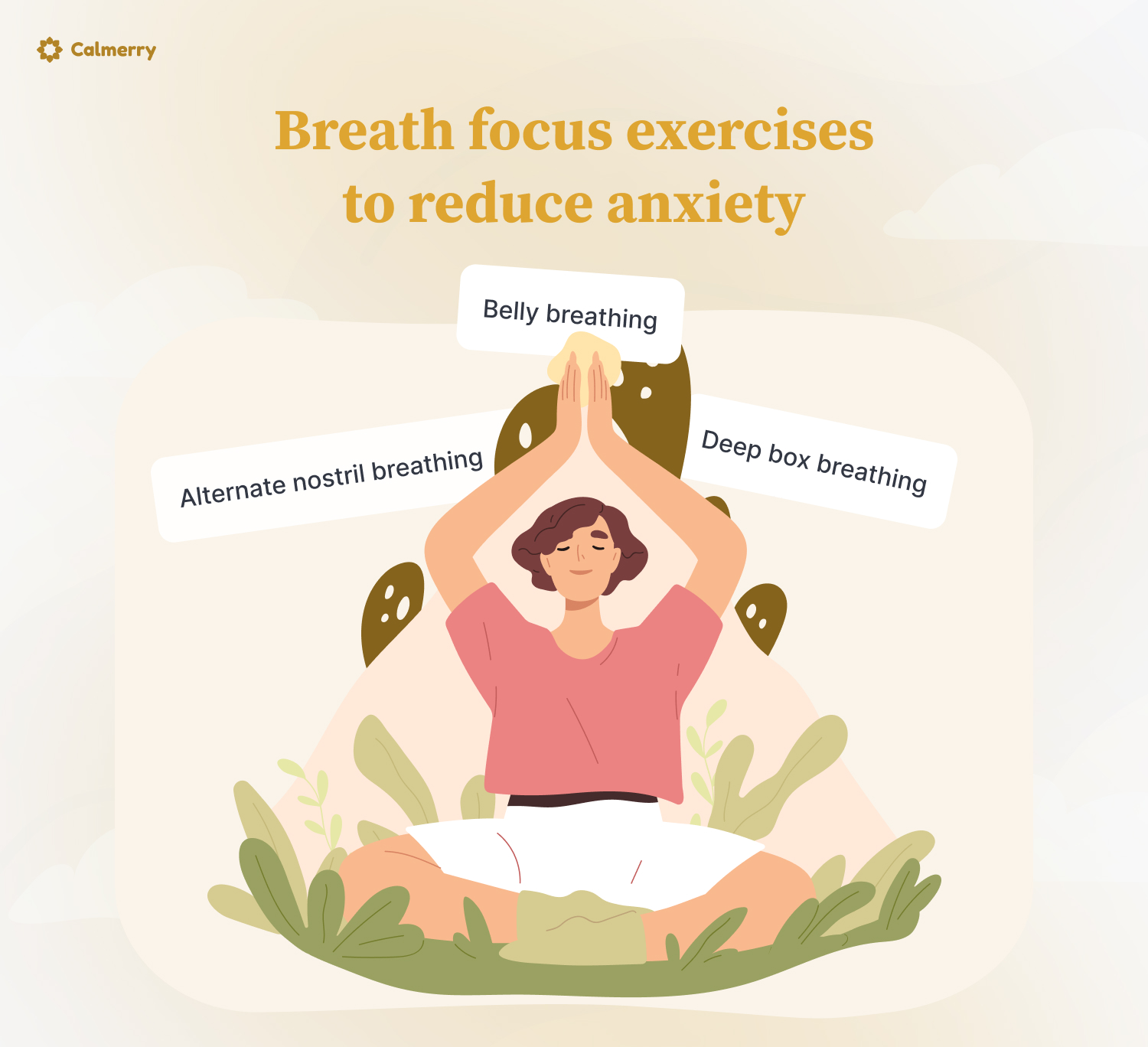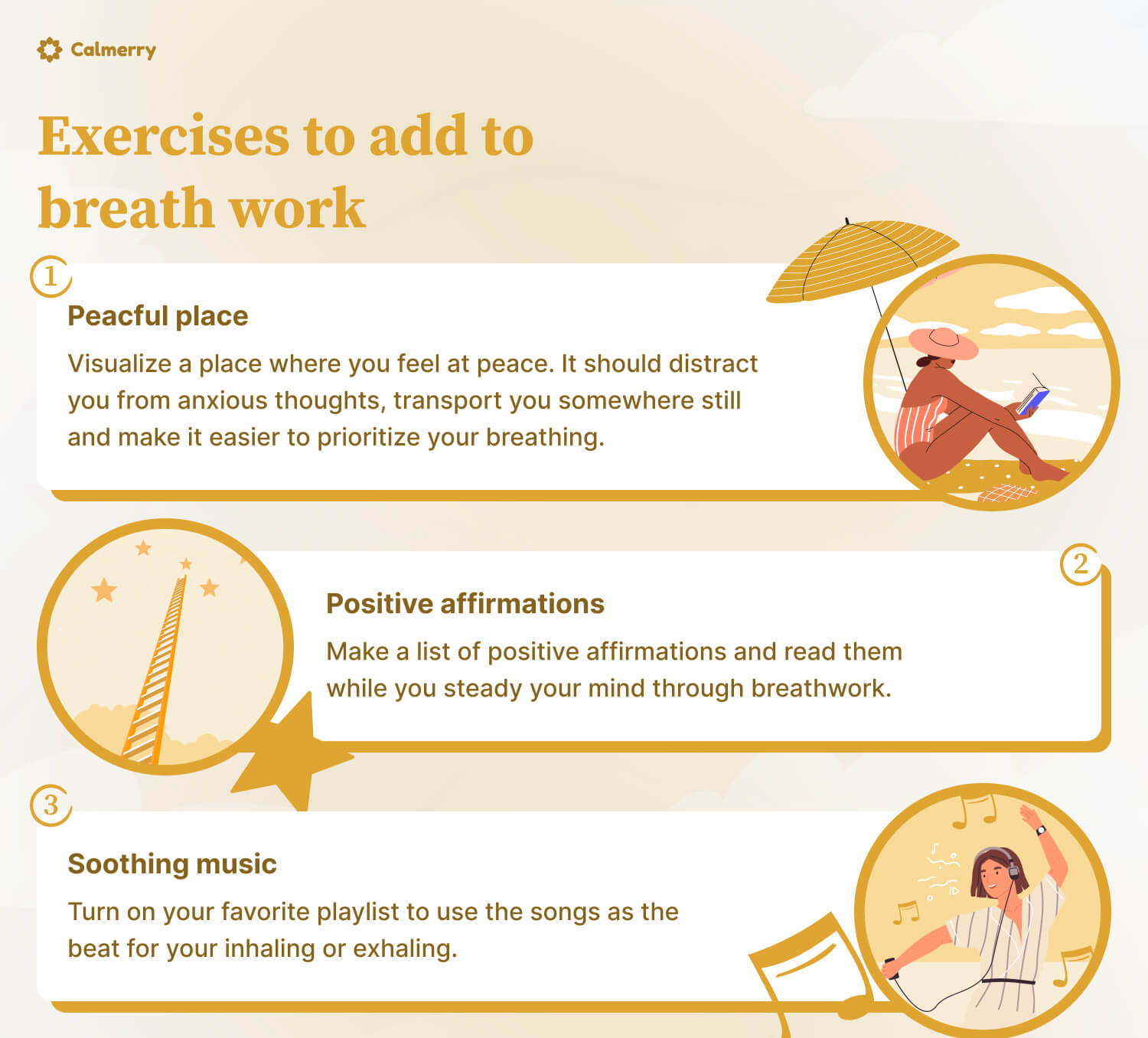Does Breath Focus Work to Reduce Anxiety?

In this article
Anxiety can feel overwhelming, but it’s never entirely out of your control. Every person can find tools that work best with their body for those moments when triggers occur.
Learning how breath focus works to reduce anxiety can help people learn to live with their anxiety.
Once they know a few techniques, they may gain greater confidence regarding their mental well-being.
What is breath focus work?
Focused breathing — also sometimes called breathing retraining — is the practice of controlling your breathing during heightened anxiety episodes. It calms the mind by slowing your heart rate while redirecting your thoughts.
It’s a useful tool for anyone with anxiety or an anxiety-related condition, like post-traumatic stress disorder (PTSD).
Scientific basis of breath focus
Breathwork moves the autonomic neural system from sympathetic to parasympathetic dominance: from fight-or-flight to rest-and-digest. Deep, slow breaths stimulate the vagus nerve, which decreases the heartbeat and relaxes the brain and the body. This physiological shift is linked with lowered levels of the stress hormone cortisol and increased activity observed in states of calm and focused attention (alpha and theta waves).
How does breath focus affect the nervous system?
When someone gets anxious, their body enters survival mode. Their nervous system perceives a threat and tries to protect them by keeping them on edge.
While this is useful in life-or-death situations, it’s a jarring daily experience when the threats don’t exist.
Experts estimate that 31.1% of American adults have lived with this condition at some point during their lives.
Concentration on breathing is a free, at-home solution for anxious moments. While people can always consult their primary care physicians for medical assistance, breathing exercises may calm their minds when they need it most.
Slow, steady breathing creates medium to large promising effects for people experiencing panic. It brings down a person’s breathing rate while they may be hyperventilating. It also sends more oxygen to the brain, which generally improves cognitive functions like processing the anxiety trigger.
Role in activating the parasympathetic system
The parasympathetic nervous system (PSNS) is the body’s natural system for conserving energy, slowing the heart, and promoting digestion. Deep breathing activates the PSNS, allowing the body to relax after stress.
The vagus nerve plays an important role in this system. Stimulation of this nerve may improve the calming influence of the PSNS, leading to lower blood pressure and general wellness. Essentially, the PSNS helps balance out the “fight or flight” response triggered by the sympathetic neural system. Balancing the calming and activating systems is important for proper health and stress management.
Evidence from neuroscientific studies
A study provides evidence on how focusing on your breath, mainly during meditation, can improve brain activity. Researchers found that practicing breath-focused meditation strengthens brain regions that are responsible for attention control and awareness of internal bodily states.
Essentially, focusing on your breath enhances your ability to concentrate and be more in tune with your body. This demonstrates a clear link between a specific meditative practice and observable changes in brain activity.
Benefits of breath focus for anxiety management
Anxiety can be overwhelming, affecting your thoughts and body. Fortunately, a very simple yet powerful tool resides within you: your breath. Focusing on respiration has a number of advantages for anxiety management. Here are some key ones:
- Calms the neural system: Slow, deep breathing activates the parasympathetic neural system, which counteracts the “fight-or-flight” response triggered by anxiety.
- Decreases physical symptoms: It can lower heart rate, diminish muscle tension, and stabilize blood pressure, alleviating common physical anxiety symptoms.
- Grounds you in the present: By paying attention to the sensation of your breath, you shift your concentration away from anxious thoughts and worries about the future or past.
- Increases self-awareness: Breathing training cultivates mindfulness, allowing you to observe your anxious thoughts and feelings without judgment, creating space between you and your anxiety.
- Improves concentration: Regular practice can improve your overall ability to concentrate and stay present, reducing the likelihood of spiraling into anxious thoughts.
Potential factors for patients to consider
People engaging in therapy for an anxiety condition can try focused breathing work to help themselves.
However, it’s important to consider a few potential factors that may influence the patient’s experience.
Air quality
Indoor air can contain numerous pollutants that harm a person’s health, like mold, lead and asbestos.
If someone practices full breathing every day in a home with those airborne pollutants, they might get sick faster than when they had shallow, standard breaths.
They can always conduct an air quality test with a smart monitor or carbon monoxide detector before focused breathing becomes part of their routine.
Sense of balance
Anyone who’s breathing quickly due to anxiety decreases the oxygen in their brain by not taking full breaths. [1] Tavel, M. E. (2020). Hyperventilation syndrome: Why is it regularly overlooked? The American Journal of Medicine, 134(1), 13–15. https://doi.org/10.1016/j.amjmed.2020.07.006 An anxiety patient may already feel dizzy when starting breath focus exercises.
If they don’t take that into consideration before taking slow breaths, they may feel too dizzy to sit or stand upright.
Average anxiety attacks
While steady breathing reduces the intensity of an anxiety attack, some people experience more extreme anxiety symptoms than others.
If a patient typically needs medical assistance when an anxiety attack starts, they should reach out for help immediately.
They could try mindfully breathing while waiting for assistance, but shouldn’t use it as a replacement for anxiety treatments like a sedative.
Breath focus exercises
When you’re ready to start focused breathing, try a few popular exercises to regulate your respiration.
They’re simple routines anyone can use to calm their nervous system and feel more grounded during anxiety-inducing situations.

1. Deep box breathing
Square breathing is an easy way to start your journey into respiratory awareness. All you need to do is picture a box. The person practicing it should imagine a box with the number four on each side. The four represents the number of seconds for each action within this breathing routine.
First, inhale for four seconds. Hold your breath for the next four seconds. Exhale slowly for another four seconds. Hold what remains of your respiration for the last four seconds.
Anyone hoping to benefit from square breathing can repeat this at least three times to feel their body start to calm. [2] Myerholtz, L. (2023). Take a deep breath. Family Medicine, 55(4), 284–285. https://doi.org/10.22454/fammed.2023.731271
It’s perfectly fine to repeat this more than three times if necessary.
If four seconds feels too long — meaning, if that length of time makes you feel automatically dizzy or panicked for air — modify this routine with four counts.
Counts are a personalized measure of time. As long as the space between each count is consistent, you or your patient can make the timing last under a second to prevent discomfort.
2. Belly breathing
Whether someone needs help overcoming the anxiety they feel before working out or giving a presentation, belly breathing can help.
It’s easy to do anywhere, even while sitting in your car at a red light.
Belly breaths are a type of diaphragmatic breathing that involves two steps.
Inhale for at least four seconds while your hand is on your belly. [3] Bentley, T. G. K., D’Andrea-Penna, G., Rakic, M., Arce, N., LaFaille, M., Berman, R., Cooley, K., & Sprimont, P. (2023). Breathing Practices for Stress and Anxiety Reduction: Conceptual Framework of Implementation Guidelines based on a systematic review of the published literature. Brain Sciences, 13(12), 1612. https://doi.org/10.3390/brainsci13121612 You should feel your diaphragm expand, extending your belly out. Exhale slowly for six seconds to start regulating anxiety breaths.
This is especially helpful for patients with shorter attention spans. If they don’t prefer the four seconds of pausing between the inhales and exhales of a box breath routine, belly breathing could be more effective.
There are a few exceptions when this breath focus exercise may not work well.
Total belly extension isn’t possible while wearing a tight belt, a seat belt, or restrictive clothing. You might need to practice shallower belly breaths in those moments, which could require a few extra minutes of breathing to experience the same anxiety relief.
3. Alternate nostril breathing
Breathing exercises don’t have to feel challenging. People with anxiety can also calm their bodies by pressing one nostril closed.
The alternate nostril breathing technique is so helpful for oxygen intake that it even improves breathing abilities for people with asthma and chronic obstructive pulmonary disease (COPD). [4] Haque, M., Jahan, I., Begum, M., Akhter, S., Islam, M., Jahan, N., Samad, N., Das, P., & Rahman, N. A. (2021). Effects of alternate nostril breathing exercise on cardiorespiratory functions in healthy young adults. Annals of African Medicine, 20(2), 69. https://doi.org/10.4103/aam.aam_114_20
Place a finger on the outside of your right nostril. Press it closed and draw in a slow, deep inhale through your left nostril.
While your lungs are full of air, press the left nostril closed and release the right one. Exhale slowly through your left nostril.
Repeat by inhaling slowly through your left nostril and exhaling through your right. You can use this if you feel winded without physical exertion or experience lightheadedness.
Continue this exercise for three to five minutes or until the anxiety fades.
If you try this exercise and don’t feel like you can get a full breath through one nostril, you might have inflammation.
In this case, you should talk with your doctor about whether you have a cold, allergies or a virus that might cause swelling in your nostrils or sinuses. The inflammation must resolve itself before this exercise can be helpful.
Exercises to add to breath work
Racing thoughts are part of dealing with an anxiety attack. Focusing on breathing might feel too slow or still during those heightened moments.
Anyone trying to do respiratory practices can add simple exercises to feel like they’re doing a more active technique without compromising their controlled breathing.

1. Visualize a peaceful place
Closing your eyes during a breathing technique is a simple way to heighten your focus. Visualize a place where you feel at peace.
This could be a real place, a destination you want to visit one day or a made-up world.
Your location should also engage your five senses to calm your mind. Focus on the details around you.
If you’re picturing a beach, how does the sand feel under your feet?
Is your skin sticky from the salty wind? Are there seagulls circling the dunes nearby?
Imagine all of this while participating in your selected breathing exercise.
It should distract you from anxious thoughts, transport you somewhere still and make it easier to prioritize your breathing for just a few minutes.
2. Practice positive affirmations
Positive affirmations manage complex feelings by training your mind to think positively. With time and practice, your mind will instinctively believe those affirmations, so you don’t need to repeat them anymore.
It’s easier to get into positive affirmations when you set a few minutes aside for breath focus work. They might also feel more helpful if you’re speaking affirmations aloud that counteract the negative thoughts intensified by anxiety.
No matter which breathing practice you prefer, enjoy a steady inhale.
Slowly say your positive affirmation out loud while exhaling. Repeating this may ease your mind and help you prolong each breath.
If you want to try this technique at home, make a list of positive affirmations during your next therapy session. You can read the affirmations off the list while you steady your mind through breathwork.
3. Listen to soothing music
Researchers have long said that classical music is an excellent way to de-stress. More recent research found that the most relaxing music genre varies between individuals. [5] Adiasto, K., Beckers, D. G. J., Van Hooff, M. L. M., Roelofs, K., & Geurts, S. a. E. (2022). Music listening and stress recovery in healthy individuals: A systematic review with meta-analysis of experimental studies. PLoS ONE, 17(6), e0270031. https://doi.org/10.1371/journal.pone.0270031
While classical music does ease anxiety, the findings noted that people also felt less anxious when listening to the genre they felt most relaxed around.
Anyone attending therapy sessions for anxiety can make a playlist for their post-therapy homework.
They should note which songs make them feel tense, on edge or breathe faster than normal. The best songs for breathwork will make them feel at peace, whether they have lyrics or not.
When it’s time to begin a breathing exercise, play the first song on the playlist.
Whoever practices the exercise can use the song as the beat for their inhaling or exhaling. They might also listen through headphones to better block out any sounds that might distract them.
You don’t need to engage in the breathing technique throughout a long playlist.
As long as the songs help you settle into the breath work, it’ll make the breathing more effective until you’re ready to stop.
Ease anxiety through regulated breathing
Respiratory techniques might sound like something you need clinical training to do, but it’s a straightforward anxiety-fighting tool. Anyone hoping to benefit from breathing techniques should give each one a try to see how it affects them.
Whether it works right away or becomes more effective with additional resources like visualization, breath focus exercises are excellent ways to reduce anxiety whenever it becomes an issue.
If anxiety continues to bother you and bring discomfort to your life, consider seeking professional help. Qualified specialists at Calmerry are always here to help you learn different coping strategies for curbing distressing thoughts.
Does deep breathing reduce anxiety? FAQ
What is breath focus, and how does it differ from other relaxation techniques?
Breath awareness involves observation of the exhale/inhale process to help promote calmness. Unlike relaxation methods, like guided imagery or progressive muscle relaxation, it emphasizes the physical act of taking a respiratory as the primary anchor for attention. Deliberate breathing practices using different breathing techniques help you feel calmer, impacting heart rate variability.
How quickly can breath focus help reduce feelings of anxiety?
Full respiratory techniques can help you calm down within minutes. Consistent respiratory practices, like resonant breathing, improve heart rate variability, reduce stress response, and help you manage anxiety in the long term.
Can breath focus replace medication or therapy for anxiety disorders?
While mindful breathing can help calm anxiety and benefit physical and mental health, they’re not a substitute for professional care. For anxiety disorders or other mental health conditions, please seek advice from your doctor. Mindful breathing can complement but not replace the treatment of anxiety.
Are there specific breathing exercises recommended for anxiety relief?
Yes, several types of breathwork may help relieve feelings of anxiety and stress in healthy adults. These include slow breathing, lion’s breath, yogic breathing, and diaphragmatic breathing.
Are there any risks or downsides to practicing breath focus?
Generally, breath control is safe. However, very rarely, shallow breaths or hyperventilation can contribute to anxiety. If you have posttraumatic stress or anxiety and panic, start slowly and under the guidance of a therapist. Deliberate breathing practices shouldn’t trigger symptoms of anxiety. Stop if you don’t feel well.
Tavel, M. E. (2020). Hyperventilation syndrome: Why is it regularly overlooked? The American Journal of Medicine, 134(1), 13–15. https://doi.org/10.1016/j.amjmed.2020.07.006
Myerholtz, L. (2023). Take a deep breath. Family Medicine, 55(4), 284–285. https://doi.org/10.22454/fammed.2023.731271
Bentley, T. G. K., D’Andrea-Penna, G., Rakic, M., Arce, N., LaFaille, M., Berman, R., Cooley, K., & Sprimont, P. (2023). Breathing Practices for Stress and Anxiety Reduction: Conceptual Framework of Implementation Guidelines based on a systematic review of the published literature. Brain Sciences, 13(12), 1612. https://doi.org/10.3390/brainsci13121612
Haque, M., Jahan, I., Begum, M., Akhter, S., Islam, M., Jahan, N., Samad, N., Das, P., & Rahman, N. A. (2021). Effects of alternate nostril breathing exercise on cardiorespiratory functions in healthy young adults. Annals of African Medicine, 20(2), 69. https://doi.org/10.4103/aam.aam_114_20
Adiasto, K., Beckers, D. G. J., Van Hooff, M. L. M., Roelofs, K., & Geurts, S. a. E. (2022). Music listening and stress recovery in healthy individuals: A systematic review with meta-analysis of experimental studies. PLoS ONE, 17(6), e0270031. https://doi.org/10.1371/journal.pone.0270031
online therapy
live video session



